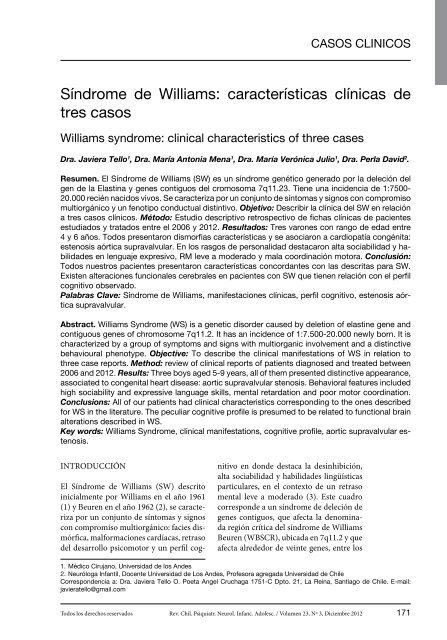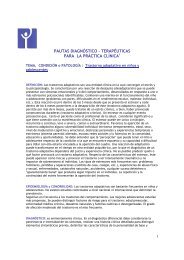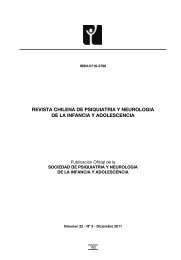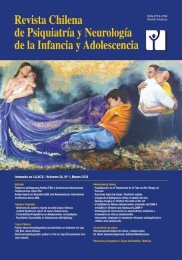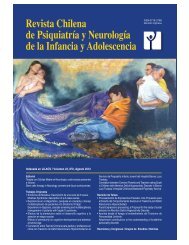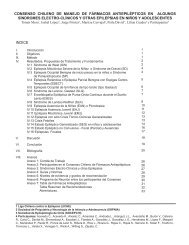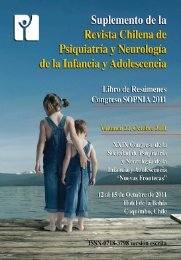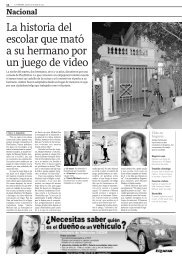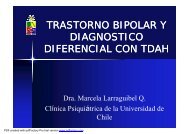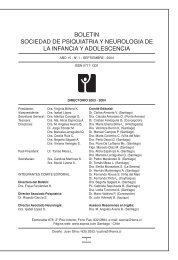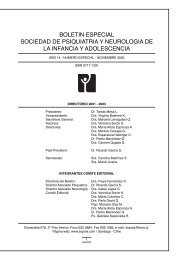Untitled - Sociedad de PsiquiatrÃa y NeurologÃa de la Infancia y ...
Untitled - Sociedad de PsiquiatrÃa y NeurologÃa de la Infancia y ...
Untitled - Sociedad de PsiquiatrÃa y NeurologÃa de la Infancia y ...
Create successful ePaper yourself
Turn your PDF publications into a flip-book with our unique Google optimized e-Paper software.
CASOS CLINICOS<br />
Síndrome <strong>de</strong> Williams: características clínicas <strong>de</strong><br />
tres casos<br />
Williams syndrome: clinical characteristics of three cases<br />
Dra. Javiera Tello 1 , Dra. María Antonia Mena 1 , Dra. María Verónica Julio 1 , Dra. Per<strong>la</strong> David 2 .<br />
Resumen. El Síndrome <strong>de</strong> Williams (SW) es un síndrome genético generado por <strong>la</strong> <strong>de</strong>leción <strong>de</strong>l<br />
gen <strong>de</strong> <strong>la</strong> E<strong>la</strong>stina y genes contiguos <strong>de</strong>l cromosoma 7q11.23. Tiene una inci<strong>de</strong>ncia <strong>de</strong> 1:7500-<br />
20.000 recién nacidos vivos. Se caracteriza por un conjunto <strong>de</strong> síntomas y signos con compromiso<br />
multiorgánico y un fenotipo conductual distintivo. Objetivo: Describir <strong>la</strong> clínica <strong>de</strong>l SW en re<strong>la</strong>ción<br />
a tres casos clínicos. Método: Estudio <strong>de</strong>scriptivo retrospectivo <strong>de</strong> fichas clínicas <strong>de</strong> pacientes<br />
estudiados y tratados entre el 2006 y 2012. Resultados: Tres varones con rango <strong>de</strong> edad entre<br />
4 y 6 años. Todos presentaron dismorfias características y se asociaron a cardiopatía congénita:<br />
estenosis aórtica supravalvu<strong>la</strong>r. En los rasgos <strong>de</strong> personalidad <strong>de</strong>stacaron alta sociabilidad y habilida<strong>de</strong>s<br />
en lenguaje expresivo, RM leve a mo<strong>de</strong>rado y ma<strong>la</strong> coordinación motora. Conclusión:<br />
Todos nuestros pacientes presentaron características concordantes con <strong>la</strong>s <strong>de</strong>scritas para SW.<br />
Existen alteraciones funcionales cerebrales en pacientes con SW que tienen re<strong>la</strong>ción con el perfil<br />
cognitivo observado.<br />
Pa<strong>la</strong>bras C<strong>la</strong>ve: Síndrome <strong>de</strong> Williams, manifestaciones clínicas, perfil cognitivo, estenosis aórtica<br />
supravalvu<strong>la</strong>r.<br />
Abstract. Williams Syndrome (WS) is a genetic disor<strong>de</strong>r caused by <strong>de</strong>letion of e<strong>la</strong>stine gene and<br />
contiguous genes of chromosome 7q11.2. It has an inci<strong>de</strong>nce of 1:7.500-20.000 newly born. It is<br />
characterized by a group of symptoms and signs with multiorganic involvement and a distinctive<br />
behavioural phenotype. Objective: To <strong>de</strong>scribe the clinical manifestations of WS in re<strong>la</strong>tion to<br />
three case reports. Method: review of clinical reports of patients diagnosed and treated between<br />
2006 and 2012. Results: Three boys aged 5-9 years, all of them presented distinctive appearance,<br />
associated to congenital heart disease: aortic supravalvu<strong>la</strong>r stenosis. Behavioral features inclu<strong>de</strong>d<br />
high sociability and expressive <strong>la</strong>nguage skills, mental retardation and poor motor coordination.<br />
Conclusions: All of our patients had clinical characteristics corresponding to the ones <strong>de</strong>scribed<br />
for WS in the literature. The peculiar cognitive profile is presumed to be re<strong>la</strong>ted to functional brain<br />
alterations <strong>de</strong>scribed in WS.<br />
Key words: Williams Syndrome, clinical manifestations, cognitive profile, aortic supravalvu<strong>la</strong>r estenosis.<br />
INTRODUCCIÓN<br />
El Síndrome <strong>de</strong> Williams (SW) <strong>de</strong>scrito<br />
inicialmente por Williams en el año 1961<br />
(1) y Beuren en el año 1962 (2), se caracteriza<br />
por un conjunto <strong>de</strong> síntomas y signos<br />
con compromiso multiorgánico: facies dismórfica,<br />
malformaciones cardíacas, retraso<br />
<strong>de</strong>l <strong>de</strong>sarrollo psicomotor y un perfil cognitivo<br />
en don<strong>de</strong> <strong>de</strong>staca <strong>la</strong> <strong>de</strong>sinhibición,<br />
alta sociabilidad y habilida<strong>de</strong>s lingüísticas<br />
particu<strong>la</strong>res, en el contexto <strong>de</strong> un retraso<br />
mental leve a mo<strong>de</strong>rado (3). Este cuadro<br />
correspon<strong>de</strong> a un síndrome <strong>de</strong> <strong>de</strong>leción <strong>de</strong><br />
genes contiguos, que afecta <strong>la</strong> <strong>de</strong>nominada<br />
región crítica <strong>de</strong>l síndrome <strong>de</strong> Williams<br />
Beuren (WBSCR), ubicada en 7q11.2 y que<br />
afecta alre<strong>de</strong>dor <strong>de</strong> veinte genes, entre los<br />
1. Médico Cirujano, Universidad <strong>de</strong> los An<strong>de</strong>s<br />
2. Neuróloga Infantil, Docente Universidad <strong>de</strong> Los An<strong>de</strong>s, Profesora agregada Universidad <strong>de</strong> Chile<br />
Correspon<strong>de</strong>ncia a: Dra. Javiera Tello O. Poeta Angel Cruchaga 1751-C Dpto. 21, La Reina, Santiago <strong>de</strong> Chile. E-mail:<br />
javieratello@gmail.com<br />
Todos los <strong>de</strong>rechos reservados Rev. Chil. Psiquiatr. Neurol. Infanc. Adolesc. / Volumen 23, Nº 3, Diciembre 2012<br />
171


